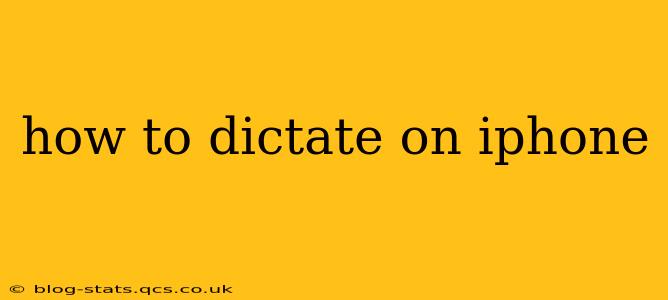Dictation on your iPhone is a powerful tool that lets you transform spoken words into text, saving you time and effort. Whether you're composing emails, writing notes, or crafting a novel, mastering iPhone dictation can significantly boost your productivity. This guide will walk you through the process, covering various scenarios and troubleshooting common issues.
How to Start Dictating on Your iPhone
The most basic method involves activating the keyboard's dictation feature. This works across almost all text input fields:
- Open the app: Launch the app where you want to type, such as Messages, Notes, Mail, or Pages.
- Tap a text field: Tap the area where you'll be entering text.
- Tap the microphone icon: Look for the small microphone icon on your keyboard. It's usually located near the spacebar. Tap it to activate dictation.
- Start speaking clearly: Begin speaking your text. The iPhone will transcribe your words in real-time.
- Add punctuation: You can verbally add punctuation marks. For example, say "comma," "period," "question mark," "new paragraph," etc.
- Stop dictating: Tap the microphone icon again to stop dictation.
Using Dictation in Different Apps
The dictation functionality works consistently across most iPhone apps that require text input. However, some apps might have slight variations in how they integrate the feature. For instance, you might find differences in the placement of the microphone icon or the app's response to specific voice commands. Experiment with different apps to understand their specific dictation behaviors.
Improving Your Dictation Accuracy
Several factors influence the accuracy of your dictation. Here are some tips for better results:
- Speak clearly and at a natural pace: Avoid mumbling or speaking too quickly.
- Use proper pronunciation: Clear pronunciation significantly improves accuracy.
- Minimize background noise: A quiet environment ensures better audio capture.
- Use punctuation commands: Incorporating verbal punctuation improves readability and structure.
- Edit your dictation: Always review and edit the transcribed text for any errors.
Troubleshooting Common Dictation Problems
H2: My iPhone isn't picking up my voice.
This could be due to several reasons:
- Microphone issue: Ensure your iPhone's microphone isn't blocked or malfunctioning. Try cleaning it gently.
- Network connectivity: Dictation relies on an internet connection. Verify you have a stable Wi-Fi or cellular connection.
- Background noise: Excessive background noise can interfere with voice recognition. Try dictating in a quieter environment.
- Software glitch: Restart your iPhone to resolve potential software issues.
H2: My dictation is inaccurate.
Inaccurate transcriptions are common, especially with unusual words, accents, or background noise. To improve accuracy:
- Speak slowly and clearly: Slowing down your speech gives the iPhone more time to process your words.
- Try different microphones: If you have external microphones, test them to see if they offer better accuracy.
- Enable "Improve Dictation Accuracy": Check your iPhone's settings to see if this option is enabled. It uses your data to refine dictation accuracy.
H2: How do I dictate emojis or special characters?
Unfortunately, standard dictation doesn't directly support emoji input. You'll need to manually add emojis after completing the dictation. Similarly, dictating special characters requires manually typing them.
H2: Can I use dictation offline?
No, iPhone dictation requires an internet connection to function. The voice recognition processing happens on Apple's servers.
By following these tips and troubleshooting steps, you can effectively harness the power of iPhone dictation to enhance your writing and communication experience. Remember, practice makes perfect – the more you use dictation, the better you'll become at achieving accurate and efficient transcriptions.
